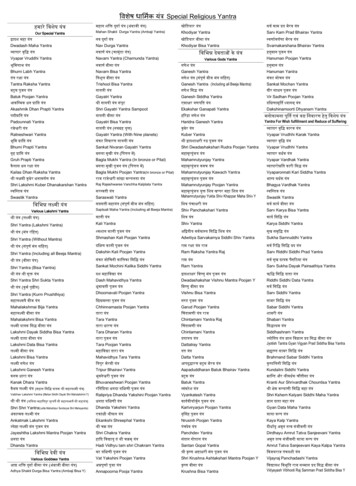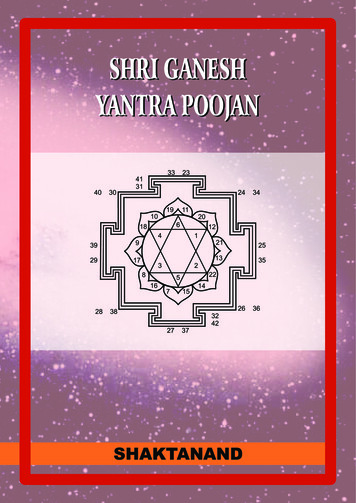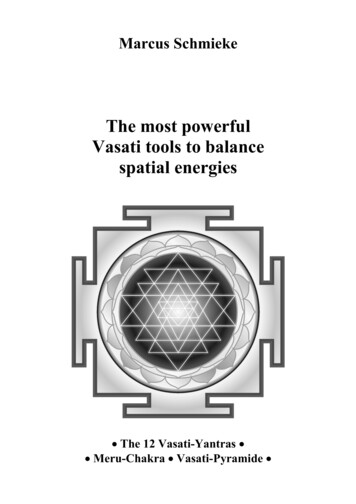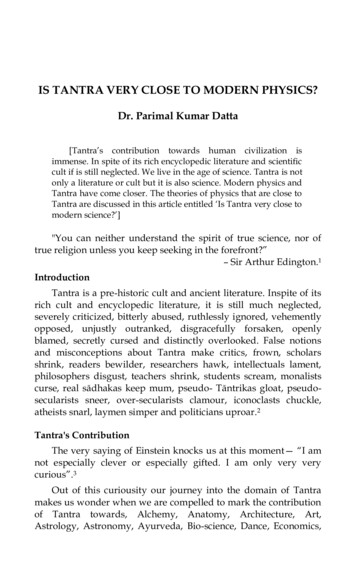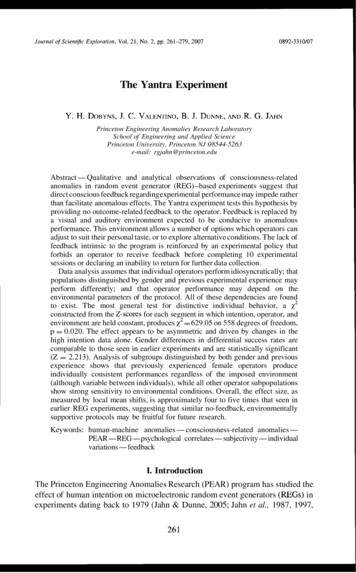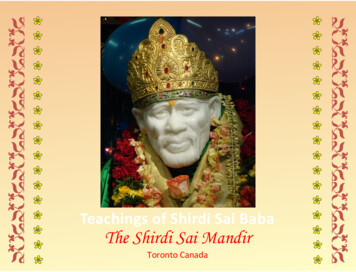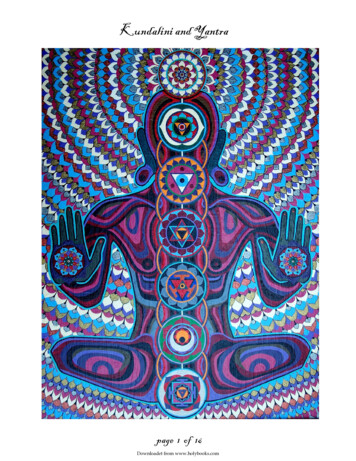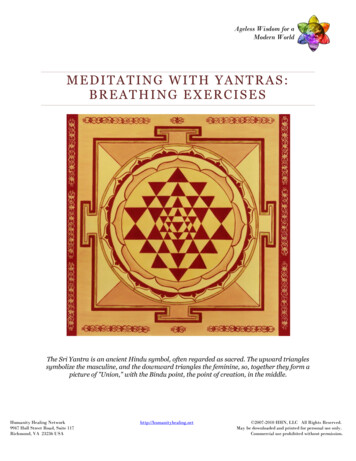
Transcription
SHRI KAALI YANTRA POOJANSHAKTANAND www.nirvanasage.com
Published by:Para Vidya Prakashan,# 3019, Sector - 27 D,Chandigarh-160019.U.T., India.Contact: shaktanandblogspot@gmail.comFirst Edition: May, 2019.Type setting and Printing:Mahindra's, Students‟ Store# 51, Panjab University,Sector - 11, Chandigarh-160011.e-copies available at :Address - www.nirvanasage.com
NIRVANA SAGE– Yantra TextS. NoMahavidya TextPage No.1.Kaali Yantra Poojan52.108 names24***********************
IntroductionMantra-Yantra-Tantra, all three combine together to represent thecompleteness of any Sadhana. The real meaning of the mantra isrepresented in the whole cosmos and thatsame meaning is represented inour body too. That is why Brahmrishi Vashishth said, 'Yatha Pinde tathaBrahmande' i.e. as is the body, same is the Cosmos.Crossing the body and the Cosmos one approaches the Bindu which is thecoordinator of Yantra.That Bindu itself is the brahm. Thus entering from the Bhoopur, realizingthe respective deities of Mandal, Shatkone, Trikone etc., one can reach thatBindu. This Bindu itself is Brahm.Hence remembering the Mantra, for doing the sadhana of the Yantrathrough the method laid down by Tantra,to realize the actual form ofYantra, is the real meaning of Sadhana. For this, one should practiceYantra-sadhana under the guidance of a qualified guide.Shri Suneet Joshi (Suyoganand Nath) has brought forward this book as amatchless present for all the Sadhaks.This is beneficial not only for studying purpose but for actual practice too.Sadhana is a thing of experience and not of argumentation. “ShradhavaanLabhate Gyanam”.Iti Sham.Jiveshwar Mishrah (Abhayanand).Vaishakh Shukla Paksha Dwadashi Samvat 2076, Vikrami.
ForewordWithout Yantra, Mantra and Tantra Prasad(fruit) of the devta is extremelydifficult. Yantra is the gross body of the Devta/divinity. Poojan, Nyas andMudra etc. are the tantra of the devta. Mantra is the causal body of thedevta. Devtas are under the control of Yantra, Tantra and Mantra.Ath Yantram Pravakshayami Devta Suprasadhanam,अथ मंत्रभ ् प्रवऺमामभ दे वता सुप्रसाधनभ ्,Yantra Bina Devta Ch Na Prasidati Sarvada.मंत्र बफना दे वता च न प्रसीदतत सववदा ।Thus one can say one should perform yantra poojan for pleasing thedevta.Yantra (मंत्र) is a mixture of two letters Yam (मं) and Tra (त्र). „Yam (मं)‟represents a support or base while „tra‟ which comes from „Tra (त्र)‟ dhatuand represents freedom from bondage. Yam is the lord of death hence wecan infer that yantra is that which provides us liberation from the bondageof life and death. Yantra is a mechanism, a machine, which works.Whenever we look at any object first we see its form which is outermanifestation and then we try to understand its symbolism which is innermanifestation. Thus we can say that a yantra represents a symbol ofconcentration. Like our houses are made as per specific designs and ownerlives in it at a particular point and to access his location a specific path wayis to be followed. Same is the case with yantras. Yantras are the geometricalrepresentation of the dwelling places of divinities or we can say that it is ageometrical representation of the energy of a specific divinity. In tantraelaborate procedures are laid down to access the yantra, the basic being theguards of the four doors. First, one has to make friends with one of them togain entry in to it. All the four are having different nature and hence theirrespective sadhanas, mantras are also mbols like Bindu. Triangleofacombinationspecific, six sided Star, Circles, 8Petal/12/16/64 ( ,) etc. petal lotuses with a square periphery allaround with four gates in the four directions. This periphery iscalled Bhoopur() and is generally made up of three equidistant lines.The other aspect of yantra is called Mantra. Mantra is said to be the keywith which one can enter in to that geometrical formation of yantra tounravel the inherent energy in it which is the specific devta whethermasculine or feminine. Scientifically we can say that a mantra comprises of–1–
seed syllables of Hindi varnmala which are chanted from specific locationof the mouth cavity. Each alphabet pertains to a specific location for itschanting carries a unique energy to it (for details read „Matrika ShaktiVilas‟). Repeated chanting of that frequency generates a thresh hold valueof specific energy which helps to open the lock of the yantra to gain accessin to it.As per tantra, coming to the concept of cosmic creation, it is said that atstart there was nothing and everything was at complete rest which wasexplained by a state of Param Shunya (zero). This param shunya thoughseemed to be empty but there were two primordial powers, Shiv (pureintelligence) and Shakti (pure dynamism) existing together in a perfectequanimity. Sensing the desire of the Shiv (pure intelligence) for creation,Shakti (pure dynamism) moved, thus a point got created in that perfectstillness or Shunya. This point was called a Bindu. Thus from the state ofsuper conscious state of Shiv and Shakti, a visual state of bindu got created.We can say that from subtle, a gross expression was established. When thewave of energy moved out of this bindu a line got created. The intersectionof the lines created a triangle, the first cosmic womb from where evolutionprocess towards manifestation of the world started. Raudri, Jyeshtha,Vama represented the three sides of this triangle which co- joined withVaikhari, Madhyama and Pashyanti while the central bindu representsPara.The above is surrounded by a square generally, known as Bhoopur whichcomprises of a combination of horizontal and vertical lines representingstatic and dynamic forces. As it is said that a sadhak experiences the realityin the chidakash (space between the brows) in the form of a circle while ayogi experiences it in the form of a square which is more evolved andbalanced. In the three lines of the Bhoopur, three sets of divinities dwell. Inthe middle line devtas of all the ten directions dwell in their specificdirection i.e. Indra (East)1, Agni (S-E)2,Yam (S)3, Nairitt (S-W)4, Varun (W)5,Vayu (NW)6, Kuber (N)7, N-E (Ishan)8, N-Brahm (N-NE)9, Anant(SW)10 respectively; in the inner line all the four dwarpaal or gate keepersreside i.e. Batuk-(South), Ganesh-(West), Yogini-(North), Kshetarpal(East); while in the outermost line ten armaments of the ten directiondivinities i.e. Vajra1, Shakti2, Dand3, Khadag4, Paash5, Ankush6,Gada7,Trident8, Padm9 and Chakra10 respectively are located to guard thefort of yantra so that no unqualified should enter it.Generally Shiva, the pure consciousness, intelligence and support isrepresented by an upward pointing triangle while Shakti, the pure–2–
dynamism, descent of energy is represented by a downward pointingtriangle. When these two superimpose, a six sided star is created. Thecreation is said to be formed with coming together of Sun, Moon and Firei.e. Surya, Chandra and Agni respectively. The matrika shaktis are dividedin to vowels and consonants. There are 16 vowels in Hindi languagerepresented by 16 Kalas of the Moon and 25 consonants of Surya and 9kalas of Agni (Fire) are there. Apart from this sometime8 petal lotus is alsomade which pertains to five elements of Space, Air, Fire, Water, Earth andthree other namely Mind (भन), Intellect (cqf)), Ego (चचत) respectively andsometimes 8 shaktis like Brahmi etc. reside there.The various geometrical formations in the yantra represent various Avaranfor poojan of different divinities or forces. This poojan is done generally intwo ways. One is called Srishti Kram (Creation) and other is called SangharKram (Dissolution). When we move from Bindu towards bhoopur it iscalled Srishti Kram and when we move from Bhoopur towards the Bindu itis called Srishti Kram. The Devi resides in the bindu. As per swabhav onefollows either of the two paths. Another important thing to be under stoodin case of yantras is the direction. Normally in a formation drawn on apaper, top corner is taken as North and right hand side is taken as East. Butin case of yantra it is rotated through 90 degrees in anti-clockwise direction.So the paper North becomes East of the Yantra and other directions alsorotate accordingly. Generally 8 directions are represented on the yantrasbut some time ten directions are also given on it. The 8 directions areNorth, South, East and West, N-E, S-E, S-W, W-N. The 9th and 10thdirection come in-between N-NE and S-SW in case of general directions ona paper but between E-NE and W-SW in case of yantra.The yantras bought from the market are on copper plates but many times asadhak has to draw them with his or her hand. In that case, bark of a bhojpatra is used. A pen made out of the pomegranate tree twig is taken todraw the yantra on a specific time. A procedure is also mentioned forgetting the apple tree twig which is being shared below. The idea herebeing to share as much knowledge as possible, with all the sinceresadhaks. Go to the pomegranate tree to request for a twig for making penfor drawing a yantra on so and so date. Chant the following sloka in frontof it and light a dhoop under it.Om! Vetalaashch Pishachashch Rakshashch Sari Saripa,(ॐ वेताराश्च पऩशाचाश्च याऺसाश्च सयीसऩृ ा)Apsarpantu Te Sarve Vrikha Asmaad Shivagya.(अऩसऩवन्तु ते सवे वऺृ �)–3–
Offer some money, jiggery, rice, supari, roli at its roots and namaskaar.ॐ नभस्ते अभतृ सम्बूते फरवीमव पववपितनफरभामीश्च भे दे हह ऩाऩन्भे त्राहह दयू तः ।Thus tell the tree on which day and date you are coming to take the twigfrom it.On the appointed day, chanting the mantra Om! Hreem Chande Hum PhatSwaha (ॐ ह्ीं चण्डे हूं पट् स्वाहा ) take the twig by breaking it with hand orwith a stone and not with any blade etc.Another important part is the ink which is to be used for making theyantra. It can be broadly divided in to two categories, masculine devta andfeminine devta.For masculine devta we should use Agar, Tagar, Kesar, Kastoori, RedChandan, White Chandan, Gorochan, Hathimad, Rose water;While for feminine devta we should use Chandan, Agar, Haldi, Kumkum,Gorochan, Shilajeet, Jatamaansi, Karpoor.Further, what kind of work we require to do with the yantra, decides as towhich day it should be made, sitting in which direction or which asan, inwhich season etc. Right now we are not going in to all those details.Though, tantra practitioners researched on it exhaustively.Moving from this outward manifestation, a sadhak graduates to the higherinner plane or realm. For him/her this very body becomes the Yantra andthe soul living within, the adya Shakti, the primordial power or the dearIsht devi. Depending upon his/ her dhyan, yearning, the inner energytakes that particular form and gives darshan. Generally, darshan isachieved in the chidakash, a space between the two eye brows. A sadhakgets darshan their in the form of a circle which is limited while a yogi getsa darshan their in the form of a square which is unlimited, as his Kundliniis fully awake right from his birth.Prostrating, One sincerely prays to the Mother, that every ardent sadhak,devotee may be blessed to reach the state of evolution where all yogisdwell and hence fulfil the purpose of the borth in this human form.Date: 26th March, 2019.ShaktanandChandigarh.–4–
Shri Kali Yantra � कृपाणम् भयं हस्तैर्वरं शर्भ्रत ,ंSadya Chinn Shirah Kripaanam Bhayam Hastaivaram Vibhrateem,घोरास्ां शिरसां स्रजा सुरुशिराम उन्मुक्त केिार्श ं ,Ghorasyaam Shirsaam Srija Suruchiraam Unmukt �र्हां श्मिान शन यां श्रुत्ोः िर्ा ंकृशतं ,Srikka Srikpravahaam Shamshaan Nilyaam Shrutyoh Shav Alankritaam,श्यामां ग कं ृ तमेख ां िर्करै र्दे र् ं भजे काश काम ।Shyaam Angi Krit Mekhalaam Shavkarairdevim Bhaje Kalikaam.–5–
Mahakali, the great goddess consort of Lord Shiva as Mahakala, is thecosmic energy beyond time and death. Durga, Adi Parashakti, become soangry during battle that kali sprang from her forehead as the ultimatedeliverer. Wild with loose hair and her tongue hanging out she gulped upall the blood from the blood-born duplicate demons and sucked up all theblood from the original demon Rakta-Bija! Victorious but enraged Kali thenate up all the demons she came across and then wore a necklace made oftheir heads. Only Shiva could stop her rage by lying down in her path. Hercolour is black. Essentially she is the highest dynamic force of ParaBrahman, and is beyond all conceptual thought and description. As thegoddess of war and of peace she is the supreme aspect of the DivineMother.–6–
–7–
Maha Kali Yantra Poojan(As per Mantra Maharnav)Yantra: Bindu, Shatkon, Trikon1, Trikon2, Trikon3, 8 Petal lotus, BhoopurYantra Gayatri:Yantra Rajaye Vidhmahe, Mahayantraye Dhimahi,Tanno Yantra Pracho Dayaat.Mantra: Om! Kreem (क्रं)x3 Hroom(ह्ूं)x2 Hreem(ह्ीं)x2 Dakshin KalikeHreem(ह्ीं)x2 Hroom(ह्ूं)x2 Kreem(क्रं)x3 Swaha(स्वाहा).Patra Establishment: Draw a downward pointing triangle in front ontheleft hand side, starting from I to 2 to 3 without taking the finger off fromthe ground with red chandan or kumkum. Do poojan of various shaktiswith flower petals at different places in the triangle as written below:At 1 : Om! Anantaya Namah; at 2 - Om! Nagaya Namah; at 3 - Om! KoormayaNamah and at 4 – Om! Shaktadharshaktaye Namah.Put the copper pot over the point 4, with astra mudra say phat over it.Chanting Om fill it with water.With Ankush Mudra attract the waters of various sacred rivers in to thepatra from the light of the Sun in the space, sayingOm! Krom Gange ch Yamune Godavari Narmade Sindhu Kaveri,Brhamndo Udra Teerthani Kare Sprishtava Te Rave,Tein Satyen Mein Deva Teertahm Dehi Diwakara.Rotate Dhenu Mudra over the pot 8 times, show Matasya mudra ovet it.–8–
With flower petals do the poojan of Surya kala, Som Kala and Agni kala inits water.Om! Ete Gandh Pushpe Ram Vanhi Mandalaya dash Kalatmane Namah,Om! Ete Gandh Pushpe Am Ark Mandalaya Dwadash Kalatmane Namah,Om! Ete Gandh Pushpe Om Som Mandalaya Shodash Kalatmane Namah.Again show Dhenu Mudra, Conch Mudra and Yoni mudra to the pot. It isnow ready to be used.Asan Establishment:Draw a Downward pointing triangle with red chandan/kumkum. Performsame poojan as done in the point 1-3 as above but in the point no 4 sayAdharshakti Kamalasnaya Namah. Spread the asan over it.Om! Asya Shri Asan Mahamantrasya Prithviyah Meruprishtha Rishih,Sutlam Chandah, Koormo Devta, Asnopvesane Viniyogah.Prithvi tvaya Dhrita loka Devi Tvam Vishnu na dhrita,Tvam Ch Dharya Ma Devi, PaviStrim Kuru Ch Asnam.Yogasnaya Namah, Veerasanaya Namah, Sharasanaya Namah.Om! Hrim Strim Hum Om! Hrim Adhar Shakti Kamalasanaya Namah.Take three sips of water form the samanya argh and drink from the base ofthe right hand palm without making any sound with following mantra,Om! Atma Tattva Shodhayami Namah,Om! Vidya Tattva Shodhayami Namah,Om! Shiv Tattva Shodhayami Namah Swaha,And wash hands on the right side of the asan sayin Om! Sarv tattvaShodhyami Namah Swaha.Purification:a).Take water from the pot in the left palm and cover it with the right palmand chant following mantra,Om! Apvitra Pavitro Va Sarva Vastham Gatoh Pivah,Ya smaredPundrikakshamSa Abhyantarah Shuchi.Om! Punatu Pundrikakshah, Punatu Pundrikakshah Punatuh.–9–
Sprinkle the water with a flower holding it with Tattva mudra of the righthand over all the people, all the articles being utilized in the poojan andself.b).Self (Bhoot Shudhi)Our body is made up of five elements and cleansing of all these is calledBhoot Shudhi. There are many short and elaborate systems for thismentioned in the different scriptures. Here we will use a simple methodthrough the cleanising of the first five chakras which represent the fiveelements in our body too.Sit in a mefitative posture on the asan. Breath in and out horizontallythrough Mooladhar chakra three times and chant LAM beej.Breath three times horizontally through Swadhishthan Chakra three timesand chant Vam beej.Breath three times horizontally through Manipur Chakra three times andchant Ram beej.Breath three times horizontally through Anahat Chakra three times andchant Yam beej.Breath three times horizontally through Vishudhi Chakra three times andchant Ham beej.Chant Ram beej and generate a blaze of fire in the stomach, increase it andburn the thumb sized paap purush there. Turn it to ashes.Repeat Yam beej and move the ashed of the space of mooladhar chakra.Chant Vam beej and knead it in to a ball.Chant Lam beej and turn it golden. Inhaling and exhaling, increase its sizeto cover the whole subtle body. Visualize the form of Hiranyagarbha forcreation of new body. Regenerate Ether, Air, Fire, Water and Earthelements a new. Regenerate the gross body.With ankush mudra attract the pranic energy from the cosmos andtouching with tattva mudra establish it into the new body with followingmantra,– 10 –
Om! Aam (आं) Hrim (ह्ीं) Krom (क्ों)Yam (मं), Ram (यं ), Lam (रं), Vam (वं)Sam (शं),ṣa (षं),ṡa (सं), Ham (हं ) Hamsa Soham, mam jivah eha Sthita.Om! Aam (आं) Hrim (ह्ीं) Krom (क्ों) Yam (मं), Ram (यं ), Lam (रं), Vam (वं),Sam (शं),ṣa (षं),ṡa (सं), Ham (हं ) Hamsa Soham Mam Sarv Indriyani EhaSthitani.Om! Aam (आं) Hrim (ह्ीं) Krom (क्ों) Yam (मं), Ram (यं ), Lam (रं), Vam (वं),Sam (शं),ṣa (षं),ṡa (सं), Ham (हं ) Hamsa Soham Mam Vang, Manah,Chakshu, Kshotra, Tvak, Ghran, Pran, Eha Gatya Sukham ChiramTishthantu Svaha.Raise the Kundlini to meet the Shiva in Sahasrar and bring it back to themooladhar.Strike the left heel on the left side of the asan three times.Clap three times downwards.Look around with strong Gaze to make all the bad spirits in the spacemove away.Samkalp:Om! Tat Sad Adya Parmatman Agya Pravart Manasya, AMUK Samvatsare,Shri Shwevarah Kalpe, Jambu Dwipe, Bharat Khande, AMUK Pradeshe,AMUK Sthane AMUK Mase (month), AMUK Gotrotpanne (gotra in whichone is born, use Kashyap Gotra if gotra not known) AMUK Sharma Aham(Name), Shri Bhagwatya Kali Prasad Sidhi Dwara Sarv AbhishthSidhyartham Yatha Shakti, Yatha Gyanen, Yatha Sambhavit UpcharDravyai Sang Avarnaih, Shri Bhagwati Kali Yantra Poojan Krishaye. TathaCh Poojadhikaar Sidhyartham Sharir Shudhyartham Ch Bhoot ShudhyadiMoolmantram Nyasadikam Karishaye.Viniyog:Om! Asya Shri Dakshin Kalika Mantrasya Bahirav Rishih, UshneekChandah, Dakshin Kalika Devta, Kreem (क्रं) Beejam, Hum (हुं) Shaktih,Kreem (क्रं) Keelkam Mam Abhisht Sidhyarthe Jape Viniyogah.– 11 –
Bahirav Rishye Namah Shirsi,Ushneek Chandase Namah Mukhe,Dakshin Kalika Devtaye Namah Hridi,Kreem Beejaye Namah Guhye,Hum Shaktaye Namah Paadayoh,Kreem Kalikaye Namah Nabhau.Viniyogaye Namah Sarvaange.Kar Nyas:Om! Kram Angusthbhyam NamahOm! Kreem Tarjani Bhyam NamahOm! Kroom Madhyama Bhyam NamahOm! Kraim Anamika Bhyam Namah,Om! Kraum Kanishtha Bhyam Namah,Om! Krah Kartal Kar Prishtha Bhyam Namah.Shadang Nyas:Om! Kram Hridyaye NamahOm! Kreem Shirse SwahaOm! Kroom Shikhaye VaukhatOm! Kraim Kavchaye Hum,Om! Kraum Netra Treyaya Vaushat,Om! Krah Astraye Phat.Prepare a space in front of the asan for establishing the yantra. Clean thespace, sprinkle vikeern over it, sprinkle water of Ganges over it, spreadflowers over it and do poojan of peeth devta sayingOm! Mam Mandukadi Partattvaant Peeth Devtabhyo Namah.– 12 –
Now do the poojan of the 9 shaktis in peeth (on which yantra is to beplaced) as follows with flowers and rice etc, starting from East side,Om! Medhayai Namah,Om! Pragyayai Namah,Om! Prabhayai Namah,Om! Vidyayai Namah,Om! Dhiyai Namah,Om! Dhrityai Namah,Om! Smrityai Namah,Om! Budhyai Namah,Om! Vishveshwaryai Namah.Now bring the yantra and bath it in Ghee, Milk and water. Wipe it cleanand smear it with Devi Asht gandh (8 ingrediant fragrance) and place it onthe flower bed sayingOm! Saraswati Yog Peeth Atmane Namah.Take a beautiful lotus or red rose in both the hands. Raise the devi fromown hear and exhale Her on to the flower and place in the middle of theyantra. Do Her poojan there after showing 05 mudras. Do Pran Pratishthaof the Yantra with Tattva Mudra,Om! Aam (आं) Hrim (ह्ीं) Krom (क्ों) Yam (मं), Ram (यं ), Lam (रं), Vam (वं)Sham (शं), ṣa (षं), ṡa (सं) Ham (हं ) Hamsa Soham, mam jivah eha Sthita.Om! Aam (आं) Hrim (ह्ीं) Krom (क्ों) Yam (मं), Ram (यं ), Lam (रं), Vam (वं),Sham (शं), ṣa (षं), ṡa (सं), Ham (हं ) Hamsa Soham Mam Sarv Indriyani EhaSthitani.Om! Aam (आं) Hrim (ह्ीं) Krom (क्ों) Yam (मं), Ram (यं ), Lam (रं), Vam (वं),Sam (शं), ṣa (षं), ṡa (सं), Ham (हं ) Hamsa Soham Mam Vang, Manah,Chakshu, Kshotra, Tvak, Ghran, Pran, Eha Gatya Sukham ChiramTishthantu Svaha.– 13 –
1st Avaran Poojan: (in the Bindu)Offering flowers and rice at the bindu of the yantra.Dyan:Shava Roodham Maha Bheemam Ghor DranshtaamHsan Mukheem,Chaturbhujaam Khadag Mund Var Abaya Karaam Shivaam,Mundmala Dahraam Devim Lallha Jihvaam Digambaraam,Aivam Sanchityet Kaleem Shamshaan Alaya Vasineem.Inner 6 Sided Star (Shat Kon) Poojan:A).1. Om! Kram (क्ां) Hridyaya Namah, Hridaya Devta Shri PadukaamPoojayami Tarpayami Namah.2. Om! Kreem (क्रं) Shirse Swaha, Shiro Devta Shri Padukaam PoojayamiTarpayami Namah.3. Om! Kroom (क्ंू ) Shikhaya Vashat, Shikha Devta Shri PadukaamPoojayami Tarpayami Namah.4. Om! Kraim (क्ैं) Kachaya Hum, Kavach Devta Shri PadukaamPoojayami Tarpayami Namah.5. Om! Kraum (क्ौं) Netra Treyaya Vaushat, Netra Devta Shri PadukaamPoojayami Tarpayami Namah.6. Om! Krah (क्ः) Astraya Phat, Astra Devta Shri Padukaam PoojayamiTarpayami Namah.Offer flowers to all and repeat the following mantra,Abhisht Sidhim Me Devi Sharanagata Vatale,Bhaktaya Samarpaye Tubhyam Pratham Avaran Archanam.2nd Avaran (6 Sided Star) Poojan:B).Perform Poojan of the shaktis on the tips of the apexes of the six sided staras detailed below, starting from the bottom angle in the anti clockwisedirection,– 14 –
DhyanSarvah Shyama Asikara, Mund Mala Vibhushitah,Tarjaneem Vaam Hastein Dharyam Tyash Susthitah.Offer flwowers, rice and water at respective places chanting the following;1. Om! Kalyai Namah, Kali Shri Padukaam Poojayami Tarpayami Namah.2. Om! Kapalinyai Namah, Kapalini Shri Padukaam Poojayami TarpayamiNamah.3. Om! Kullayai Namah, Kulla Shri Padukaam Poojayami TarpayamiNamah.4. Om! Kuru-Kullayai Namah, Kuru-Kulla Shri Padukaam PoojayamiTarpayami Namah.5. Om! Virodhinyai Namah, Virodhini Shri Padukaam PoojayamiTarpayami Namah.6. Om! Viprichitayai Namah, Viprichita Shri Padukaam PoojayamiTarpayami Namah.Offer flowers and Rice repeating the following mantra,Abhisht Sidhim Me Devi Sharanagata Vatale,Bhaktaya Samarpaye Tubhyam Dwitya Avaran Archanam.3rd Avaran Poojan:In the 1st inner triangle of the yantra perform poojan of the following withflower, Rice and Water;In front angle of the 1st triangle,7. Om! Ugrayai Namah, Ugra Shri Padukaam Poojayami TarpayamiNamah.On the left side,8. Om! Ugra Prabhayai Namah, Ugra Prabha Padukaam PoojayamiTarpayami Namah.On the right side,9. Om! Deeptayai Namah, Deepta Shri Padukaam Poojayami TarpayamiNamah.– 15 –
In the 2nd Triangle:10. Om! Neelayai Namah, Neela Shri Padukaam Poojayami TarpayamiNamah.11. Om! Dhanayai Namah, Dhana Shri Padukaam Poojayami TarpayamiNamah.12. Om! Balakikayai Namah,Tarpayami Namah.BalakikaShriPadukaamPoojayamiIn the 3rd Triangle:13. Om! Matrayai Namah, Matra Shri Padukaam Poojayami TarpayamiNamah.14. Om! Mudrayai Namah, Mudra Shri Padukaam Poojayami TarpayamiNamah.15. Om! Mitrayai Namah, Mitra Shri Padukaam Poojyami TarpayamiNamah.Offer Flowers to all the Shaktis, Repeat Kali mool mantra and chantfollowing sloka,Abhisht Sidhim Me Devi Sharanagata Vatale,Bhaktaya Samarpaye Tubhyam Tritya Avaran Archanam.4th Avaran Poojan (8 Petal Lotus Poojan):Perform poojan in the clockwise direction with Flower, Rice and water asshown,DhyanDandam Kamandlum Pashchadaksh Sootram Mahabhayam,Vibhrati Kanak Chaya Brahm Krishnajino Ujjwalam,Shoolam ParshwadhamKshudra Dundubhim Nri Karotikaam,Vahanti Him Sankasha Dheya Maheshwari Shubha,Ankusham Dand Khatwangau Paasham Ch Dadhti Karaih,Bandhuk Pushp Sankasha Kumari Kaam Dayani,ChakramGhantaam Kapalam Ch Shankham Ch Dadhti Karaih,Tamal Shyamala Dhyeya Vaishnavi Vibhram Ujjwala,Moosalam Karvalam Ch KhetakamDadhti Halam,Karaih Chturbhir Varahi Dhyeya Kaalghanah Chavih,– 16 –
Ankusham Tomaram Vidyut Kulisham Vibhrati Karaih,Indra Neel Nibhedrani Dhyayeya Sarv Smridhida,Shoolam Kripanam Nri Shirah Kapalam Dadhti Karaih,Mund Sring Mandita Dhyeya Chamunda Rakt Vigraha,Aksh Srajam Beej Pooram Kapalam Dadhti Karaih,Vahanti Hem Sankasha Moh Luxmi Sameeritah.16. Om! Brahmayai Namah, Brahmi Shri Padukaam Poojayami TarpayamiNamah.17. Om! Narayanyai Namah, Narayani Shri Padukaam PoojayamiTarpayami Namah.18. Om! Maheshwaryai Namah, Maheshwari Shri Padukaam PoojayamiTarpayami Namah.19. Om! Chamundayai Namah, Chamunda Shri Padukaam PoojayamiTarpayami Namah.20. Om! Kaumaryai Namah,Tarpayami Namah.KaumariShriPadukaamPoojayami21. Om! Aprajitayai Namah, Aprajita Shri Padukaam Poojayami TarpayamiNamah.22. Om! Varahyai Namah, Varahii Shri Padukaam Poojayami TarpayamiNamah.23. Om! Naarsinghyai Namah, Naarsinghi Shri Padukaam PoojayamiTarpayami Namah.Offer Flowers to all the Shaktis, Repeat Kali mool mantra and chantfollowing sloka,Abhisht Sidhim Me Devi Sharanagata Vatale,Bhaktaya Samarpaye Tubhyam Chaturtha Avaran Archanam.5th Avaran Poojan (Bhoopur):Asht Bhairav Dhyan and Pooja:Do the poojan of 8-Bhairav inside the Bhoopur at various places in anticlockwise direction as shown below with Flower, Rice and water;– 17 –
Bhairav DhyanBheeshansyam Tri Nayanam, Ardh Chandra Vibhushitaam,Sfatikabham Kanikadi, Bhoosha ShatSamaa Yutam,Asht Varsha Vyaskam Ch, Kuntalo Lasitam Bhaje,Dhaaryantam Dand Shoole, Bhairavyadi Samaa Yutam.24. Om! Aim (ऐं) Hrim (ह्ीं) Am (अं) Asitaang Bhairavaya Namah, AsitaangBhairav Shree Padukaam Poojayami Tarpayami Namah.25. Om! Aim (ऐं) Hrim (ह्ीं) Im (इं) Ruru Bhairavaya Namah, Ruru BhairavShree Padukaam Poojayami Tarpayami Namah.26. Om! Aim (ऐं) Hrim (ह्ीं) Um (उं ) Chand Bhairavaya Namah, ChandBhairav Shree Padukaam Poojayami Tarpayami Namah.27. Om! Aim (ऐं) Hrim (ह्ीं) Rim (ऋं) Krodh Bhairavaya Namah, KrodhBhairav Shree Padukaam Poojayami Tarpayami Namah.28. Om! Aim (ऐं) Hrim (ह्ीं) Lrim (ऌं ) Unmat Bhairavaya Namah, UnmatBhairav Shree Padukaam Poojayami Tarpayami Namah.29. Om! Aim (ऐं) Hrim (ह्ीं) em (एं) Kapali Bhairavaya Namah, KapaliBhairav Shree Padukaam Poojayami Tarpayami Namah.30. Om! Aim (ऐं) Hrim (ह्ीं) Ôm (ओं) Bheeshan Bhairavaya Namah, BheeshanBhairav Shree Padukaam Poojayami Tarpayami Namah.31. Om! Aim (ऐं) Hrim (ह्ीं) Am (अं) Sanghaar Bhairavaya Namah, SanghaarBhairav Shree Padukaam Poojayami Tarpayami Namah.Do the poojan of 8-Bhairavavis inside the Bhoopur at various places inclockwise direction as shown with Flower, Rice and waterBhairavi DhyanBhavyechh Mahadevim Chandra Koti Yut Prabham,Himkundendu Dhawlaam Panch Vaktra Trilochanaam,Ashtadash Bhujair YuktaamSarvanand Karodyataam,Parahsanteem Vishaal Aksheem Dev Devasya Sam Mukhim.32. Om! Shreem (श्ीं) Shree Bhairavyai Namah, Shree Bhairavi ShriPadukaam Poojayami Tarpayami Namah.– 18 –
33. Om! Mam (भं) Maha-Bhairavyai Namah, Maha-Bhairavi Shri PadukaamPoojayami Tarpayami Namah.34. Om! Sim (मसं) Singh-Bhairavyai Namah, Singh-Bhairavi Shri PadukaamPoojayami Tarpayami Namah.35. Om! Dhoom (ध)ूं Dhumra-Bhairavyai Namah, Dhumra-Bhairavi ShriPadukaam Poojayami Tarpayami Namah.36. Om! Bheem (बीं) Bheem-Bhairavyai Namah, Bheem-Bhairavi ShriPadukaam Poojayami Tarpayami Namah.37. Om! Um (उं ) Unmat-Bhairavyai Namah,Padukaam Poojayami Tarpayami Namah.Unmat-BhairaviShri38. Om! Vam (वं) Vashikaran-Bhairavyai Namah, Vashikaran-Bhairavi ShriPadukaam Poojayami Tarpayami Namah.39. Om! Mom (भों) Mohan Bhairavyai Namah, Mohan Bhairavi ShriPadukaam Poojayami Tarpayami Namah.Offer Flowers to all the Shaktis, Repeat Kali mool mantra and chantfollowing sloka,Abhisht Sidhim Me Devi Sharanagata Vatale,Bhaktaya Samarpaye Tubhyam Pancham Avaran Archanam.6th Avaran Poojan: Perform the poojan of the direction devtas and theirarmaments as below,There are three lines in the bhoopur (outside square of the yantra) withfour doors in the four directions. In the 1st inner line of the Bhoopur, inthe door ways do the poojan of the guards (Starting from East side) withFlowers,Rice and water as follows,40. South Gate:Om! Shrom Hrim Kleem Glaum Gam Ganpatye Var Varad Sarvjanm MeVashmanya Swaha.Shri Ganpati Shri Padukaam Poojayami, Tarpayami Namah.– 19 –
41. Western Gate:Om! Hrim Bam Batukaya Apudhdharnaya Kuru Kuru Batukaya Hrim.Shri Batuk Shri Padukam Poojayami Tarpyami Namah.42. North Gate:Om! Yam (मं) Yim (मीं) Yum (मूं )Yaim (मैं)Yaum (मौं) Yah (म:) Yoginibhayah PhatSwaha.Shri Yogini Shri Padukaam Poojayami Tarpayami Namah.43. Eastern Gate:Om! Ksham (ऺं) Kshetrapalaya Namah.Shri Kshetrapal Shri Padukaam Pojayami Tarpayami Namah.In the second inner square line of Bhoopur, perform the poojan of tendivinites as below, offering flowers, rice and water to each one:44. EastOm! Lam (रं) Indraye Namah, Indra Shri Padukam Poojayami Tarpayami Namah.45. East-SouthOm! Ram (यं ) Agnaye Namah, Agni Shri Padukam Poojayami Tarpayami Namah.46. SouthOm! Yam (मं) Yamaye Namah, Yam Shri Padukam Poojayami Tarpayami Namah.47. South WestOm! Ksham (ऺं) Nairittye Namah, Naritti Shri Padukam Poojayami TarpayamiNamah.48. WestOm! Vam (वं) Varunaye Namah, Varun Shri Padukam Poojayami TarpayamiNamah.– 20 –
49. North WestOm! Yam (मं) Vayavye Namah, Vayave Shri Padukam Poojayami TarpayamiNamah.50. NorthOm! Kum (कुं) Kuberaye Namah, Kuber Shri Padukam Poojayami TarpayamiNamah.51. North EastOm! Ham (हं ) Ishanaye Namah, Ishan Shri Padukam Poojayami TarpayamiNamah.52. North-NEOm! Aaam (आं) Brahmane Namah, Brahm Shri Padukam Poojayami TarpayamiNamah.53. South-SWOm! Hrim (ह्ीं) Anantaye Namah, Anant Shri Padukam Poojayami TarpayamiNamah.In outer 3rd line of the Bhoopur do Poojan of all the armamentsIn the outermost line of the Bhoopar, starting from East direction, do thepoojan of the armaments of the ten directions divinities as belowwithFlower, Rice a
Mantra-Yantra-Tantra, all three combine together to represent the completeness of any Sadhana. The real meaning of the mantra is represented in the whole cosmos and thatsame meaning is represented in our body too. That is why Brahmrishi Vashishth said, 'Yatha Pinde
